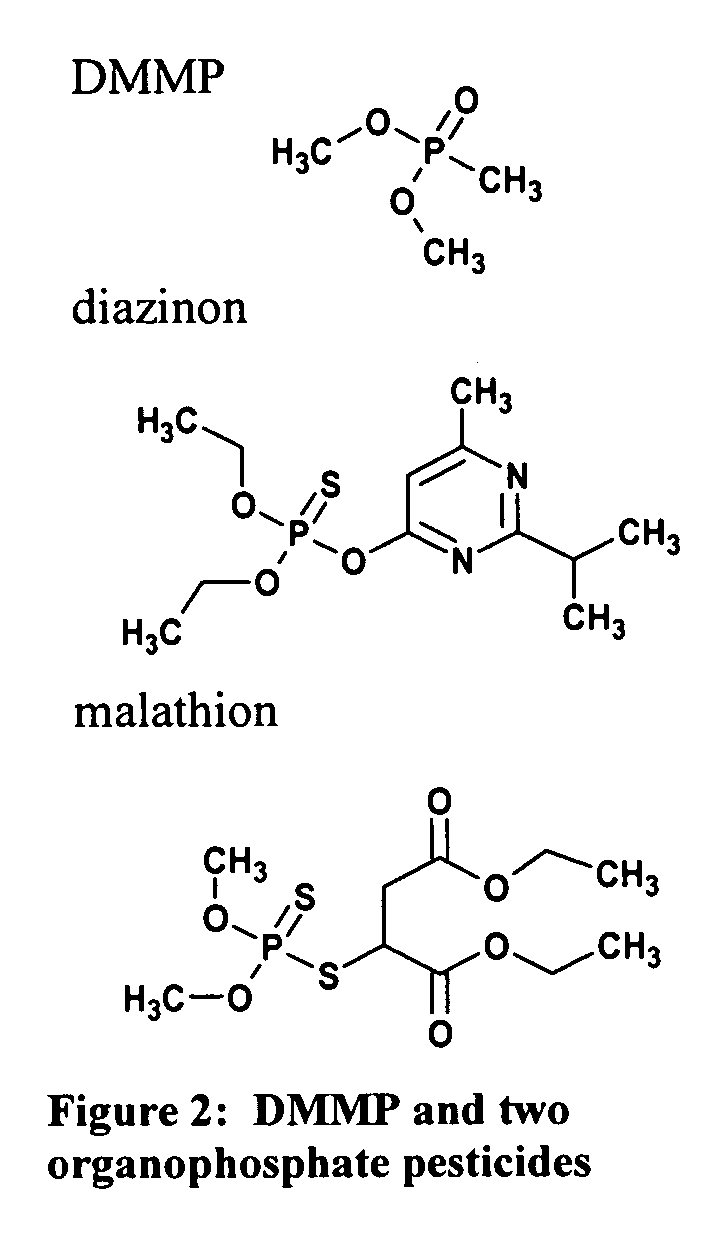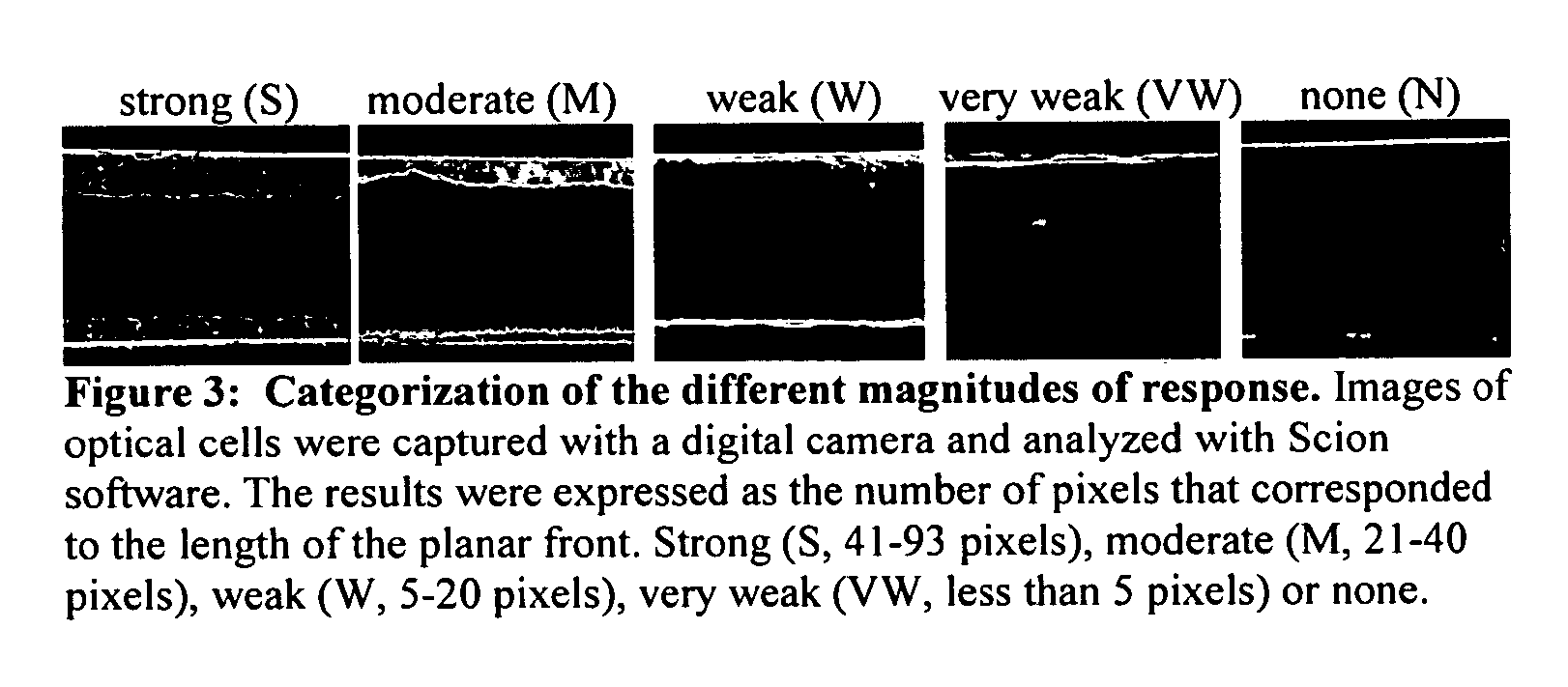Detection of analytes
a technology of analytes and detection methods, applied in the field of detection of analytes, can solve the problems of lack of monitoring data to estimate exposure, the number of registered uses of these ops has been significantly reduced,
- Summary
- Abstract
- Description
- Claims
- Application Information
AI Technical Summary
Problems solved by technology
Method used
Image
Examples
example 1
[0232] This example describes the identification of metal ion receptors that can be used for detection of OP compounds. This screen was performed by using a “closed” optical cell comprised of two surfaces treated with the metal ions, as shown in FIG. 1. The two surfaces decorated with the metal ions were prepared by (I) depositing ultrathin (optically transparent) gold films onto glass microscope slides by electron beam deposition, (II) forming self-assembled monolayers of mercaptoundecanoic acid (MUA) on the surfaces of the gold films, and (III) immersing the treated gold surface into ethanolic solutions of metal salts to form the metal carboxylates on the surfaces of the films. Uniformly gold coated AlSi glass slides (75 Angstrom gold with 15 Angstrom of titanium) are immersed in to a 1 mM ethanolic solution of MUA and rinsed with Ethanol for 20 seconds and dried with Nitrogen gas. These substrates are cut in to 2.5×2.5 cm squares and spin coated with 1 mM metal perchlorate (35 mi...
example 2
[0242] This example describes the use of liquid crystal assays for measurement of instantaneous and cumulative exposure to targeted compounds. For these experiments, DMMP was used as a model OP analyte.
[0243]FIG. 9 shows the response of a closed cell to cumulative exposure to DMMP over a 24 hour period. Inspection of FIG. 9 reveals the time-dependent progress of a bright front from the edge of the optical cell towards to the middle. The front is caused by the diffusion of the DMMP into the LC, and the triggering of a change in orientation of the LC, as described in FIG. 1. Measurement of the distance of penetration of the DMMP in the LC provides a quantitative measure of cumulative exposure.
[0244] The results shown in FIG. 10 demonstrate that the rate of progress of the front into the LC depends on the concentration of the DMMP. Thus the distance of penetration of the front indicates a convolution of the time and concentration of exposure to DMMP.
[0245] An analysis of the results...
example 3
[0251] This example demonstrates the use of liquid crystal assay devices to measure cumulative exposure to organophosphate-based pesticides. The results in Table 3 summarize a screening of candidate metal ions for their response to Malathion and Diazinon. Because commercial formulations of pesticides contain a number of additives (e.g., surfactants to control wetting), the response of the LC to commercial formulations and purified Diazinon were compared (they were similar). The results in Table 3 indicate the successful identification of metal ions that report both Malathion and Diazinon. Note that the vapor pressures for Malathion and Diazinon are 5.25×10−5 atm at 30° C. and 9.57×10−10 atm at 20° C., respectively.
TABLE 3Qualitative response of optical cells to 20 hour pesticide exposure. The cells were fabricatedusing chemically-treated (1 mM MUA / 1 mM metal perchlorate) gold-coated glass slides. The cells were loadedwith E7 liquid crystal. Five metals, Co2+, Cu2+, Mn2+, Ni2+ and ...
PUM
| Property | Measurement | Unit |
|---|---|---|
| width | aaaaa | aaaaa |
| width | aaaaa | aaaaa |
| length | aaaaa | aaaaa |
Abstract
Description
Claims
Application Information
 Login to View More
Login to View More - R&D
- Intellectual Property
- Life Sciences
- Materials
- Tech Scout
- Unparalleled Data Quality
- Higher Quality Content
- 60% Fewer Hallucinations
Browse by: Latest US Patents, China's latest patents, Technical Efficacy Thesaurus, Application Domain, Technology Topic, Popular Technical Reports.
© 2025 PatSnap. All rights reserved.Legal|Privacy policy|Modern Slavery Act Transparency Statement|Sitemap|About US| Contact US: help@patsnap.com



